Thursday, September 29, 2011
Lost Kayakers
No, none of us at Kayak Yak know the missing men. But that doesn't make the story any better.
When we comment here on our blog about boating safety, or getting a new PFD like John did on the weekend, or practising wet exits and re-entry, it's not just a bunch of hot air. This is the kind of stuff that can save your life -- or lose it.
Sooke basin is a terrific place to paddle. We've been there many times, mostly on calm days. Sometimes we challenged ourselves with steady wind and waves, or consistent currents. The bay seems so sheltered until the wind changes direction. Once we launch, it's easy to get away from the sound and sight of the town and of the houses scattered along some of the shore. And a couple of times, we've faced a few challenges that seemed perfectly fine ten seconds earlier. So far we've all come home, and we've even brought our boats home.
Even in familiar places, it's possible for a person in a kayak or other small boat to have unexpected problems. I hope that anyone reading our blog takes safety seriously -- personal safety and group safety! Accidents happen to everyone. Sometimes being prepared helps.
Last weekend I came to shore on Cadboro Bay's Gyro Park beach just as a young man was launching. We said hi to each other, and he glanced at my kayak's deck.
"Too much stuff," he said.
Well, I did have a spare paddle, water pump, and throw bag of rope on the front deck, and a paddle float on the back. (Mike Jackson stores all that gear inside his cockpit, because he wants a clear deck so he can roll. I can't roll.) I shrugged and said, "Safety gear."
He shook his head. "Too much."
Did I take him more seriously because he was in a well-worn kayak, a muscular First Nations man with a fishing line looped on his deck? Did I take him less seriously because he wasn't wearing a PFD or a kayak skirt?
I thought about him when hearing the news reports of the missing kayakers off Sooke. A PFD won't always save your life... it might keep one from drowning long enough to die of cold, and in these cold waters that can take about half an hour. Then it makes you easier to find.
All the safety gear we carry (and it's required by law here in Canada) is no guarantee of safety. It's just tools that might be useful. We have put them to use, too.
It's hard waiting to hear the news reports from Sooke.
Be careful out there.
Sunday, September 25, 2011
Ocean River's 30th Anniversary
Saturday, September 24, 2011
Ocean River Gear Grab

....although it seemed like some people would wear almost any disguise to sneak in.

We checked out the boats....

...and Louise checked out a couple of them very closely.

We got away lightly this time. Louise didn't buy anything, and I replaced my long-serving Kokatat PFD with the latest model. And we saw something that you don't see everyday:

He was either plugging Icebreaker , or one of the start of semester parties got a little out of hand last night.
Wednesday, September 21, 2011
Tall ships and warships and kayaks, oh my! (Sunday September 18, 2011)

So, on paper (on screen), the itinerary looked awful, despite my having the tolerance for lousy connections that comes with being a hardened veteran of public transit. As of Labour Day weekend, only one of the four navettes to Parc des Îles de Boucherville is still ferrying. The (hourly from 1000) ferry leaves on the hour. The (hourly) Sunday bus to the ferry arrives at the nearest stop 2 minutes to the hour, with a long, high footbridge over the highway between stop and dock. On the way back, the (hourly until 1730) ferry leaves the island at half past the hour. The (hourly) bus leaves the stop near the dock about 28 minutes past the hour. Added to that, this ferry pulls in at a jetty on Île Charron an extra 1 km of path away from the kayak rental.
But it was an ideal kayaking day, and I live in the neighbourhood of a stadium. The morning of a big game usually features successive serenades by tow trucks, brass bands (though I harbour a secret pleasure at the irreverence of the Pink Panther at 9 am on the sabbath), and vocals ("Oh Ceh-neh-deh!"). There should be a fine for amplifying any singer who cannot. Hit. That. High. Note. On. Key. I had been out at Parc de la Riviere (I will find that grave accent on the keyboard yet) the previous Sunday and spent 7 hours in a kayak (probably qualifying as one of my 5 longest paddles), so I decided I would head for the ferry.
Leg one of the Great Trek was by Bixi down to the Old Port, which I found busy for a Sunday forenoon, having forgotten the tall ships had sailed into Montréal on Thursday. Four were still in dock, and I paused to take a photo and then carried on west along the promenade. The next nautical attraction was not one to pass with a mere snapshot: frigate HMCS Montréal moored with pennants flying and gangplank down. I found a dock for the Bixi and trotted aboard for a good peer at the ship and all its gear (at least the gear they were willing to show off). Since kayaking leaves one very aware of stability, I am still baffled as to how they launch their Sea-Sparrow missiles without, well, turning over. The angle of the harpoon anti-ship missiles made sense, in that when the rig is in launch position the thrust must be towards the middle of the ship, but the Sea-Sparrows are housed laterally and appear to launch vertically. Must read up.


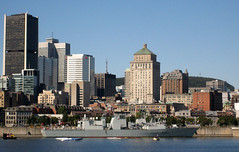
Around 11:30 I collected my Bixi again (same bike), and set off for Parc Jean Drapeau, which involves describing a big hairpin to come at the Parc via Pont de la Concorde. I had to make Metro Longuiel-Université de Sherbrooke by 41 minutes past the hour to catch the 81 bus - the bus that would probably arrive in time for me to miss the ferry. I continued at my own pace, pausing to take a couple of pictures from the other side of the harbour, and rolled up to the Bixi station beside the Metro at Parc Jean Drapeau at 12:20. Lots of open docks, check. None of which were willing to accept my bike. Finally, after I had tried every dock at least once, one grudgingly gave me the green light, and freed me to plunge down the stairs into the metro station. . . . As the masses began pouring out, a outbound train having come and gone.
So there went another 5 minutes. I rode 1 stop under the river, got off the train and scampered. Well, proceeded on impulse power. Seemed silly to miss the bus now. The bus complex has big windows onto the bus parking area, so you can see your bus on approach, and know when to engage warp engines. I caught the bus, 12:41. Along with a little tot whose mother - who looked about thirteen years old - would never lose her in the long grass. Or, indeed, anywhere short of a rock concert.
The bus hit its mark at the appointed time, and I scurried for the footbridge. From the footbridge, I saw the ferry below at its dock, with a line of people with bikes, loading. Scurry faster. Down stairs, along a few dozen yards, skid down gravel path, and arrive to find that they were full and had to come back for myself and another couple. Which they promised to do. So we hung out on the docks, bobbing as the speedboats tore past, and 10 minutes later, back came the ferry. We'd loaded and cast off when a young family, complete with tot (silent tot) in trailer bike, pulled up, and our captain looped back to collect them. With that and a couple more strays, we had a full cargo of people and bikes.

It's a quick trip, just across the narrow strip of the St Laurent between Îles de Boucherville and Boucherville. We offloaded adjacent to a boat ramp that was already stacked with boat trailers depositing boats. Once again, I was the only bikeless passenger, and was shortly all alone (but for a few assorted butterflies), tramping around the opening of the highway tunnel (I'm sorry, it is just so wrong to have a 4-lane highway come up from the underworld on an island which is a park). Across Île Charron on the way to the entrance of the park, and down the south side of Île Sainte-Marguerite. I estimated it would take me close to an hour, and it did, though I was not hurrying. Temperature was probably close to 20C, but the air was so clear that the sun had a Calgary feel to it, hot. There was a constant silver noise of cicadas.
I reached the location d'embarcations about 1:40, and paused for a quick lunch before getting to the point of the day. No queue, no crowd on the beach, quite a contrast to my first trip. Red Kayak, Ookpik, with a rudder I never did get to cooperate with me, fixed unfeathered paddle, which felt too short until I was in the reeds. I calculated I had about 2 hours before I would have to make tracks for the dock, because if I missed the 1730 ferry my options would be (a) hitch a lift, (b) call for a taxi, or (c) check into the hotel on the island until next Saturday. I had no desire to fight with criss-crossing wakes, even if there was no wind to speak of, so I turned left/north/up La Grande Riviere and, well, the pictures speak for themselves. Blue sky, round little decorative clouds, and water like glass. I threaded through the reeds for most of the way along the north leg in Chenal le Courant before I hit my turnaround time. There were a few close encounters with fellow paddlers and canoeists in the narrow channels. Canadian politeness seemed to make us compete as to who could move furthest out of the way, leaving 2 boats discretely trying to extricate themselves. Two herons, on the wing, and what I suspect was a kingfisher, with a striking white stripe on the neck. In the photos, the water looks faintly marbled from the weeds, visible through the clear water. An abundance of tiny fish in the shallow waters of Grande Riviere, and some larger ones in the deeper open areas of Chenal le Courant.




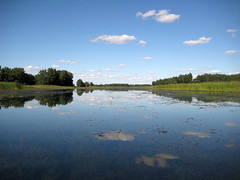
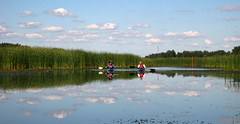
Back to the rental, park boat, deliver gear, collect ID, take a couple more photos, knowing I would probably not make another trip before the ferry stopped running after Thanksgiving weekend. Paths were busier on the way back, but still not nearly as busy as they were in July. Arrived at ferry dock about 5 pm, thinking I might be lucky, and they might be shuttling passengers at need, but there was no sign of the ferry. I sat and and watched the antics at the adjacent boat ramp, with boats ringed around the ramp and cars and trucks with trailers queued back along the road waiting to pick up or offload. I'd thought the ferry might be full, which was the other impetus for getting back early, but when we left, we had about eight aboard, including a flushed couple of cyclists who had done a very fast final km. By the time I reached the bus stop in the shadow of the bridge, I was looking at a 50 min wait.

I started walking, along Boulevard Marie-Victorin, with road and humming highway between me and the water, and standard suburbia on the other side. My knees had been wingeing ever since I got out of the kayak, and they stepped up their complaints as the road opened out before me, though it was the low sun in my eyes that eventually made me decide just to stake my spot in a shaded bus shelter, and wait. I detoured via a Macs for a bottle of gatorade and a chocolate bar. Call it rehydration and replenishing glycogen stores, ok? And settled down to read "Sheepfarmer's Daughter" (Elizabeth Moon) from the Baen Free Library on my iPod touch until the bus came.
Bus to Metro Longuiel-Université de Sherbrooke, Yellow line to Berri-UQUAM, Orange to Metro Sherbrooke, and La Popessa spaghetti house for fettucini a l'Atlantique, which seemed appropriate. So in summary, I kayaked for 2 hours. Biked for probably 2 hours. Walked for 2.5 hours (not counting the time spent aboard HMCS Montréal). Rode various forms of public transit for another hour or so. Definitely did not fulfil Alison's optimum of paddling time > travel time. But I was lucky on the way out, and psychologically prepared for the return, the sky was blue, there was no wind, and the water was like glass . . . [Edited September 22 to add some more photos]
Sunday, September 18, 2011
Reno-cation 2011!
Having yanked the carpet out of the living room a couple of months ago, this was the week we planned to do a little flooring and painting.
First up, we needed to sand the hardwood floor in the living room.

This house is about 70 years old, and this is the original hardwood floor. When my parents bought the house in 1972, the floor was covered in wall to wall green carpet. My parents replaced the carpet a couple of times through the years, and knew that the original floor was underneath, but never actually saw it. They lived in the era when carpet was king - funny how times change.
We rented a power sander and Bernie volunteered to take it for a spin. A retired woodworker by trade, this is the sort of project he loves to work on.

After a few minutes, there was so much sand being kicked up that Bernie suddenly realized that he had forgotten to put on his Darth Vader mask.

In between sanding passes, came the ironing.

The idea here is that compressions in the wood (like the one below) from years of heavy furniture sitting on it can be alleviated to some degree by ironing a wet towel over the affected areas. The idea is that the steam expands the compressed wood fibres so that they can be sanded to more closely match the surrounding wood.

It was a long and gruelling first day, and we were sure ready to eat when dinner time rolled around. Unfortunately, we weren't going to eat in the dining room, as it was a little crowded in there. Someone had moved our living room into it.

(Bonus Points if you can spot the cats in the picture. Hint: there's two.)
Day Two was a little easier, as we began with hole filing. The Inspector stood in the doorway behind Bernie to make sure his work was satisfactory.

The old floor has taken a beating over the years, but is in good shape. But there's lots of nail holes around the edges near the walls and the fireplace from when the carpet had been laid, but for the most part the floor is quite serviceable. We filled them with filler and sanded them down.
Once the Inspector gave his approval....
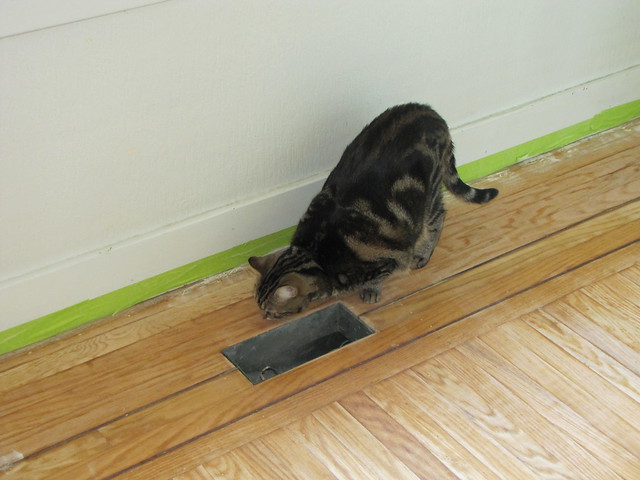
....Bernie set to work applying coats of finish to the floor. Then he broke our bathroom sink. But I digress.
Here's the change in the floor colour as the finish went on:

Day Three began with Bernie and I giving the floor another quick sanding before applying more coats of finish.

The Inspector gave the room another quick look over...

...then Bernie applied a final coat.

We took a few hours off, then Louise and I began to prep for tomorrow's painting.

Either we're Number One, or I'm flashing back to the only procedure I learned in proctology school.
I was hoping to get away without much sanding, but when we pulled off the tape we'd put around the baseboards in case the floor finish splashed on the walls, the tape pulled off some paint, and we had a surprise. The baseboards were oak, just like the floor. And it looks like it was my parents who decided to paint over them as there was only one colour of paint on them.

Then the house gave us another surprise. We took off the large mirror off the wall over the mantelpiece without any idea what we might find. We found a niche in the wall containing a golden idol! Quick, someone get me a bag of sand! No, too much -- pour a little bit out!

Okay, so no golden idol, but it turns out that the original colour of the wall was a yellow-gold colour. With some sort of recess in the wall for a light or clock or something. I could still see some old wring there for a small receptacle. Suddenly, the memory flooded back. When my parents bought the house in 1972, my father rewired the whole house, but he didn't replace a couple of special plugs in the house (like the one in the recess and the one in the bathroom vanity) because although they were the norm when the home was built, they were against code by the 1970s. So my folks decided to cover up the hole by hanging a mirror, and they never even painted the wall first.
And now, painting: Day Four was trim and ceiling....
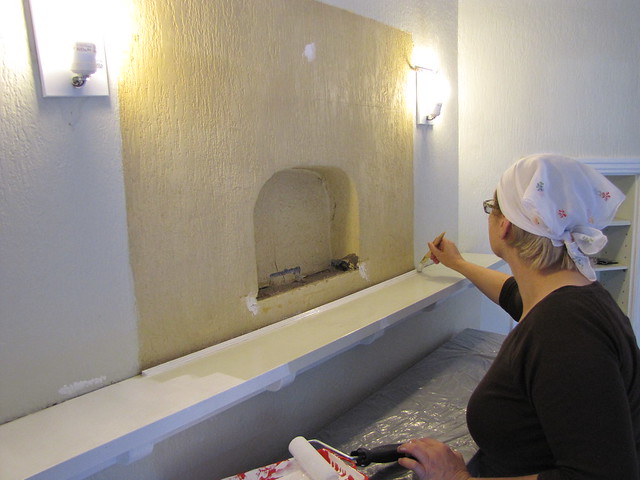
...and Day Five and Six were colour on the walls...

....and did we pick a lot of colour! But we love it! Here's the finished result.

By this point the Inspector had lost all interest.

We decided this should go behind the mirror. Something for archaeologists a century from now to ponder.

And we weren't done yet -- Days Seven and Eight we moved on the dining room. From this....
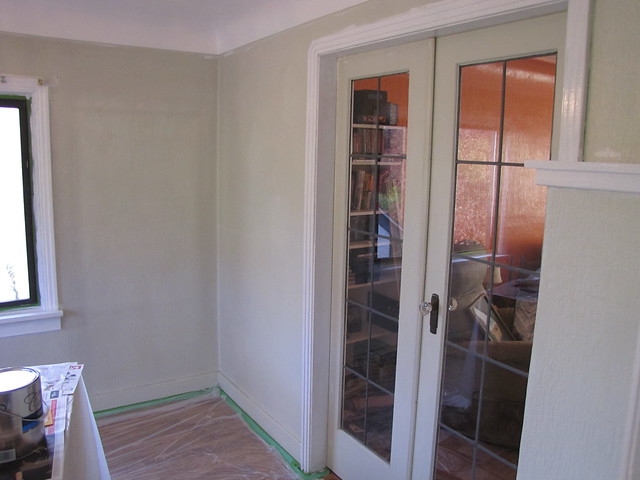
to this.

The Inspector and his assistant approved. But they insist that we've spent enough time at home and we must go kayaking next weekend.

Friday, September 16, 2011
Planning for Applefest on SaltSpring!
Applefest is a great reason to visit SaltSpring Island, so maybe next year. Another good reason is paddling in Fulford Harbour or Ganges Harbour. But for that, we'll have to see who is interested either in driving onto the ferry with kayaks on their vehicle roofs, or walking on and trundling one of my inflatable kayaks behind them.
Next year, I wonder if the weather will be good enough to camp the night at the campground in Ganges... October is sometimes pretty cold, especially if it rains.
If you haven't been to an Applefest, check out their videos on YouTube.
Thursday, September 15, 2011
Paddle to the Amazon
2 years. 12,000 miles. 20,000,000 paddle strokes.
Yet somehow, they pulled it off. Between the arduous paddling, the over-zealous soldiers and policía, terrible weather, and bouts of near-starvation and intestinal upsets, Don and Dana somehow survive, not always because of Don's skill as an expedition leader (or some may say lack thereof), but often only thanks to the kindness and generosity of some of the poorest people on the planet.
Don's diary is a classic story of adventure and survival against insane odds. Well worth checking out.
Monday, September 12, 2011
More Than I Needed To Know About Barnacles
Barnacles are the bane of a fine kayak's existance. Well, maybe not the bane, but they're a danger to a fine finish on a kayak, anyway. Well, they are if the kayaker makes a habit of paddling along shorelines and in rock gardens.
And I do. My Eliza kayak from Necky has left skinny curls of pink plastic on barnacled rocks pretty much everywhere we go.
 I can remember the first time John took his new blue Delta 14 kayak along the shoreline between Telegraph Bay and Gordon Head... He paused to take a photo of an eagle and got a little distracted. Sure enough, his kayak drifted over a rock that hid just under the surface of the water. The boomer had a couple of barnacles on it, and one scratched a line that went an embarrassing distance along the hull. Two years later, he sold that kayak, but a month later I spotted it on someone else's car roof rack. You know how I recognised it... yup, by that light but distinctive scratch.
I can remember the first time John took his new blue Delta 14 kayak along the shoreline between Telegraph Bay and Gordon Head... He paused to take a photo of an eagle and got a little distracted. Sure enough, his kayak drifted over a rock that hid just under the surface of the water. The boomer had a couple of barnacles on it, and one scratched a line that went an embarrassing distance along the hull. Two years later, he sold that kayak, but a month later I spotted it on someone else's car roof rack. You know how I recognised it... yup, by that light but distinctive scratch.Yeah, yeah, it's not the barnacles' fault. Those immobile little arthropods don't leap up and actively scratch my boat. If I kept a better eye on the rocks, there'd be no problem at all. So I decided to learn more about barnacles, since there are a lot of them in places I like to go. And besides, they look kind of neat when the tide comes in and all their feathery little feet come out to reach around, looking for food.
Something came to mind that biologist Amy Groesbeck told me when we were taking a clam sample in Waiatt Bay this summer. A researcher at Bamfield Marine Research Station has been learning things about barnacles that most of us will never get to see. Apparently, while barnacles are all hermaphrodites, their male equipment is more than one would expect, based on their body size. And adaptable to wave conditions. They're one of the few immobile species that has to couple, and well, that's about as far as I can take this story.
But don't let it end there. Check out the video that's been posted showing a romantic barnacle interlude.
Saturday, September 10, 2011
Talking About Salmon Farms
Salmon are a big issue here in British Columbia! We Straitwatch volunteers knew that most of what resident killer whales eat is salmon. Humans like these oily fishes, too, locally and around the world. "In the last two decades, global consumption of salmon has risen from 27,000 tons to more than 1 million tons annually," noted McKay Jenkins in his book What’s Gotten Into Us? Staying Healthy In A Toxic World. That's a lot of salmon. And much of the salmon we eat comes from fish farms. "So, what is it about farmed salmon anyway?" one of the volunteers asked. "What's different about it?" He wondered why anyone could complain to the Cohen Commission about fish farms. After all, fish farms supply a lot of food. People need food. If a million tons of wild salmon were harvested every year, there might not be any wild salmon left to spawn in some rivers.
 Part of the difference, we explained, is that the farmed salmon doesn't taste the same as wild salmon. Wild fish grow up eating a lot of small sealife, especially tiny invertebrates that look like shrimp. That's why salmon flesh is a pink or red colour. Farmed salmon are fed ground-up fish made into pellets. Without their natural food, the flesh of farmed salmon is more pale and less firm than wild salmon. The food pellets are very convenient for the fish farmers, but some people worry about what might be in the pellets. Pollution like heavy metals or industrial chemicals can build up in the food chain, affecting both fish and humans. "Farmed salmon turn out to have ‘significantly higher’ levels of flame retardants than wild fish, likely because they are fed ground-up fish that are themselves contaminated," McKay Jenkins observed.
Part of the difference, we explained, is that the farmed salmon doesn't taste the same as wild salmon. Wild fish grow up eating a lot of small sealife, especially tiny invertebrates that look like shrimp. That's why salmon flesh is a pink or red colour. Farmed salmon are fed ground-up fish made into pellets. Without their natural food, the flesh of farmed salmon is more pale and less firm than wild salmon. The food pellets are very convenient for the fish farmers, but some people worry about what might be in the pellets. Pollution like heavy metals or industrial chemicals can build up in the food chain, affecting both fish and humans. "Farmed salmon turn out to have ‘significantly higher’ levels of flame retardants than wild fish, likely because they are fed ground-up fish that are themselves contaminated," McKay Jenkins observed.
Another difference that we notice here on the Pacific coast is that most of the farmed fish are Atlantic salmon, thousands of miles from the habitat where they evolved. These farmed salmon are raised in large nets, suspended in small ocean bays. The salmon in a farm don't have freedom to move about over a wide area and scatter their wastes. Under the farms, the muck piles up on the sea bottom. "Salmon farms are dangerous to wild salmon," wrote marine biologist Alexandra Morton on her website, "because they create a place where viruses, bacteria and parasites breed." Wild salmon migrating past the farms might get sick. The Coastal Alliance for Aquaculture Reform promotes on their website the idea of farming salmon and other fish in closed containers, instead of enclosure nets in narrow sea inlets along the salmon migration routes.
Biologists are taking samples, and bringing their findings to the Cohen Commission. But this Royal commission gets different reports from every expert who testifies! The Norwegian companies building the salmon farms say the germs are no problem. Clam harvesters near salmon farms claim that the clam beds are affected. It won't be easy for the best laws to be written to protect wild salmon as well as support sustainable business development. At each city the commission visits, the public audiences get to see history being made.
Thursday, September 08, 2011
Departmental Meeting
Well!
I think you can guess that I made my way over to Willows Beach at the appointed time... by kayak.
 And had a marvelous time. One of the professors is the proud owner of a new double kayak, and wants to join the Kayak Yak people for a paddle outing one day soon. Another student and I have started a kayak chat group on the department's student website. As well, one of the courses I'm taking is taught by Dr Misao Dean. She was the proud recipient of a federal grant from the Social Sciences and Humanities Research Council, a couple of years ago, for a project on "inheriting a canoe paddle" about the impact of the canoe on Canadian nationalism.
And had a marvelous time. One of the professors is the proud owner of a new double kayak, and wants to join the Kayak Yak people for a paddle outing one day soon. Another student and I have started a kayak chat group on the department's student website. As well, one of the courses I'm taking is taught by Dr Misao Dean. She was the proud recipient of a federal grant from the Social Sciences and Humanities Research Council, a couple of years ago, for a project on "inheriting a canoe paddle" about the impact of the canoe on Canadian nationalism.I think I'm going to like studying here!
 It was a good day to paddle solo along the Upland shore past the big rock garden. The seal that John photographed a day later was sunbathing on a rock. Biiiiig seal. Either a great big male harbour seal, or possibly a young elephant seal. Either way, a very calm fellow.
It was a good day to paddle solo along the Upland shore past the big rock garden. The seal that John photographed a day later was sunbathing on a rock. Biiiiig seal. Either a great big male harbour seal, or possibly a young elephant seal. Either way, a very calm fellow.
Monday, September 05, 2011
Seagull With A Mohawk

We rolled the kayaks down the hill, entered at the Victoria Canoe and Kayak Club launch point, and we were off. The tide was flooding under the Tillicum Bridge so we went for a quick look and saw a lone seal, far away from the open ocean, enjoying a playful ride in the current.

A few minutes later we discovered one of the more interesting seagulls we've seen. May I present Seagull With A Mohawk.

We first noticed him as he flew to the shore carrying some sort of shell. We thought that it may have been a crab shell, or maybe a clam. (I don't do shellfish, a shell is a shell.) Anyway, he landed on shore and spent a few minutes eating whatever was on the inside of the shell, then looked up and saw that there was another seagull on the beach a few metres away. This second seagull was paying no attention to Mohawk (or his lovely breakfast) but clearly Mohawk was feeling threatened so he dropped his meal and ran up to the other seagull and did a bit wing-flapping and squawking. He returned to his meal, but seagull #2 didn't get the hint, and Mohawk ran up and squawked again. He didn't take "no" for an answer and forced seagull #2 off the beach and into the air. Mohawk pursued him into the air, hoping to get the point across that he was not welcome. Louise and I watched the aerial dogfight, the two seagulls swooping and diving over our heads. Also watching were two crows that had sneaked up to Mohawk's dropped meal and finished it off. Mohawk returned to his empty shell, sighed (really! I swear he did!) and flew off.
A moment later....

...he had dredged up another shell and was finishing off the insides.
Cormorant Tree, often covered in cormorants, held only one today.

We continued on into Portage Inlet where the herons were out in force today.

Mohawk wasn't the only bird having good luck with food.

I thought I was cleverly sneaking up on this heron from behind. No such luck -- he knew I was there.

We also saw a few of the gelatinous egg sacks that we see in the waters here every fall. They seem to be a few weeks behind, but then everything is behind after the lousy spring.

The egg sack is the little round thing in the middle. The other brown lumpy things are sponges.
There's a lot of geese around now. They know winter is coming and so are heading south and using the parks in the area as a rest area.

With only limited time today, we quickly turned back.

Trip Length: 7.30 km
YTD: 202.14 km
More pictures are here.



